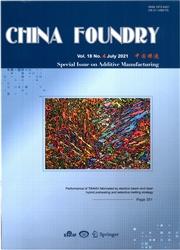烧结温度对3D打印聚硅氮烷增强Al2O3芯材微观结构和性能的影响
IF 2.3
3区 材料科学
Q2 Materials Science
引用次数: 1
摘要
陶瓷芯是航空发动机中空叶片的关键中间部件。传统的工艺,如热压成型和凝胶膜铸造,由于模具的复杂性和漫长的工艺周期,在制造复杂结构的陶瓷芯时面临困难。立体光刻3D打印技术为复杂结构陶瓷芯的制造提供了新的思路。研究了烧结温度对掺杂10vol的al2o3基陶瓷芯的开孔率、容重、失重率、收缩率、抗弯强度和微观结构的影响。对%聚硅氮烷(PSZ)进行了研究。分析了psz增强陶瓷芯的烧结机理。结果表明,psz增强陶瓷芯的最佳烧结温度为1450℃。在此温度下,陶瓷芯的开孔率为36.60%,容重为2.33 g·cm−3,失重率为22.11%,X、Y、Z方向收缩率分别为5.72%、5.01%、9.61%;25℃时抗弯强度为28.794 MPa, 1500℃时抗弯强度为13.649 MPa。3D打印psz增强陶瓷芯的性能可以满足高温合金空心叶片的铸造要求,有望推动3D打印复杂结构陶瓷芯的工业应用。本文章由计算机程序翻译,如有差异,请以英文原文为准。
Effect of sintering temperature on microstructure and properties of 3D printing polysilazane reinforced Al2O3 core
Ceramic cores are the key intermediate components of hollow blades for aero-engine. Conventional processes, such as hot-press molding and gel film casting, face difficulties in fabricating complex-structured ceramic cores due to the complexity of moulds and long process cycles. Stereolithography 3D printing provides a new idea for the fabrication of complex-structured ceramic cores. The effect of sintering temperature on open porosity, bulk density, weight loss rate, shrinkage rate, flexural strength and microstructure of the Al2O3-based ceramic core doped with 10vol.% polysilazane (PSZ) was studied. The sintering mechanism of PSZ-reinforced ceramic cores was analyzed. Results show that the optimum sintering temperature of PSZ-reinforced ceramic cores is 1,450 °C. At this temperature, the open porosity of the ceramic core is 36.60%, bulk density is 2.33 g·cm−3, weight loss rate is 22.11%, shrinkage rate along the X, Y, Z directions is 5.72%, 5.01%, 9.61%, respectively; the flexural strength is 28.794 MPa at 25 °C and 13.649 MPa at 1,500 °C. Properties of 3D printing PSZ-reinforced ceramic cores can meet the casting requirement of superalloy hollow blades, which is expected to promote the industrial application of 3D printing complex structure ceramic cores.
求助全文
通过发布文献求助,成功后即可免费获取论文全文。
去求助
来源期刊

China Foundry
工程技术-冶金工程
CiteScore
2.10
自引率
25.00%
发文量
1646
审稿时长
3.0 months
期刊介绍:
China Foundry, published bimonthly to a worldwide readership, mainly reports on advanced scientific and technical achievements, applied technology, production successes, management and leadership, recent developments and industry information in the foundry field. Coverage encompasses all casting technologies and includes, but is not limited to, novel and net shape casting technologies; casting alloy design and modification; control of nucleation, solidification and microstructure & mechanical properties; computer aided design; rapid prototyping; mold making, mold materials and binders; mold and gating design; melting and liquid-metal treatment and transport; modeling and simulation of metal flow and solidification; post-casting treatments; quality control and non-destructive testing; process automation and robotics; and safety and environmental issues.
 求助内容:
求助内容: 应助结果提醒方式:
应助结果提醒方式:


